Palm Trees, Skateboards and the Japanese-Language Proficiency Test
Junichi Kumagai
The Japan Foundation Center for Japanese-Language Testing
On December 4, 2011, Japanese learners sat for the Japanese-Language Proficiency Test (JLPT) in 60 countries and regions around the globe. I visited the test venue at the University of Southern California in Los Angeles, one of the 196 cities hosting the exam throughout the world. Here is a short report on how things went on the day of the test.
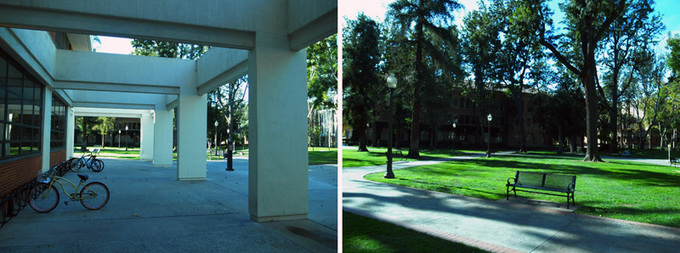
Test site: University of Southern California
Work began early in the morning at the test center. I had envisioned Los Angeles as a warm place, what with the images I had of the palm trees, but on this day a strong wind was blowing and it was actually quite chilly. I met the other staff members at the university, where they arrived in cars loaded with equipment and test materials. We got right to work carrying stuff into the building. Work went smoothly, thanks to the staff's thoughtful advance preparations--for instance, small items like pens and erasers were already bagged and marked to indicate where they needed to go. After making sure that everything was in place, a meeting was held for the staff who would be supervising the test in the classrooms. Since everyone had to come early, we were treated to Krispy Kreme doughnuts and Starbucks coffee for breakfast.
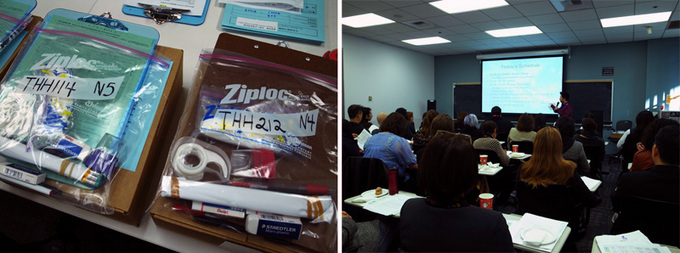 Left: Classroom preparations
Left: Classroom preparations
Right: The supervisors' meeting
Once the briefing was over, the supervisors headed to their assigned rooms to get things ready for the test. They made sure the desks were evenly spaced, wrote the test times and instructions on the whiteboard, checked that the CD player for the listening test was working properly, and adjusted the volume. When all the preparations were complete, the staff was free to take a lunch break before the test takers began arriving in the afternoon. Lunch, by the way, was a sandwich from Subway. The two meals--breakfast and lunch--made me feel very American.
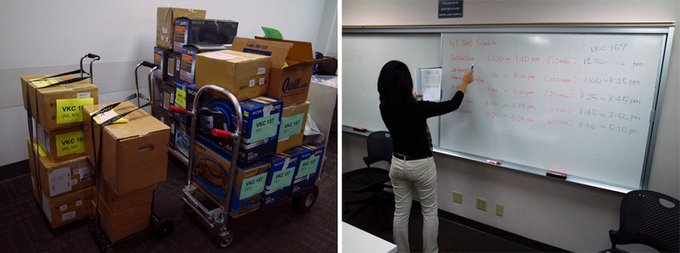
Left: The CD players and other materials for the listening test
Right: A supervisor writing instructions on the white board
I stepped outside after the lunch break. Looking around the buildings where the test was going to take place, I found the candidates spending the last few minutes before the test each in his or her own way. Some were holding textbooks, busy taking one last look at their vocabulary lists; others were chatting cheerfully with their peers. When I sat for the university entrance exams years ago, I remember cramming until the very last instant, burying myself in a vocabulary book with headphones on. I just couldn't stand that nerve-racking wait before an exam, so I would try to keep calm by listening to my favorite song--"Pinkerton" by Weezer, which, incidentally, is a band from LA! I was relieved to see that the atmosphere at the University of Southern California was more relaxed. When the doors opened, the candidates began to make their way into the building, each clutching an admission ticket with an ID number on it. I made a silent wish that they would all do their best on the test. At that very moment a man on a skateboard swished past behind me and disappeared into the building. Now, that is America, right there, I thought, struck by the casual, easy-going feeling.
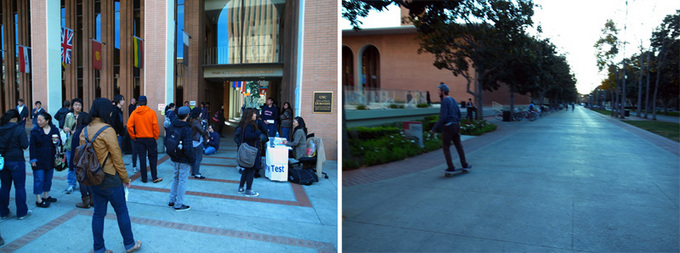
Left: The entrance hall right before the doors opened
Right: A candidate arriving on his skateboard
The entrance area was almost empty by the time the test was about to begin. In the JLPT, test takers must present themselves in the classroom no later than ten minutes after the starting time of the test. In other words, you can be up to ten minutes late, but any later than that you are disqualified. These last crucial minutes are when incidents usually occur, and today was no exception. There was the young man who forgot to bring his admission ticket. He went back to get it in such a hurry that he ran up the stairs at full speed; by the time he made it to the test center he was so tired his legs could barely support him. There was a young woman who, like a seasoned marathon runner, kept on running despite losing her shoe on the way. She darted into the classroom right before the critical ten minutes were up. Then there was a display of family ties that could have been a scene from a Hollywood movie: on arriving at the test center the candidate realized she had left her ID document at home, so her father drove back to the house to get it. When dad returned with the document, the candidate's brother, who was apparently waiting for the father at the parking lot, snatched the document and ran to his sister at the building entrance and handed it to her, like a runner passing a baton in a relay race. It was very nicely played.
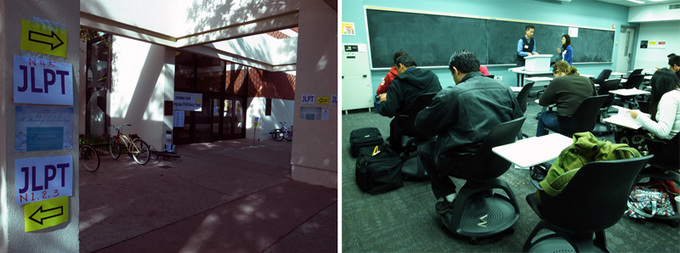
Left: Directions on the campus
Right: Test takers filling out a questionnaire
I could not see inside the classrooms during the test because I had to work the whole time in the head offices set up in each of the buildings, but I could feel the tension filling the hallways. After a few hours the long test was finally over, and the candidates spilled out of the classrooms. No doubt some of them sailed through the test, while others didn't do so well, but, as one of the organizers, I was just happy that the exam itself had gone off without a hitch. My congratulations to the staff and the candidates on a job well done!
In my work, I handle telephone and email inquiries about the JLPT from test takers of every nationality on a daily basis. However, sitting in the office in Yotsuya, Tokyo, I rarely have the chance to actually meet the test takers in person. Why are they studying Japanese, and what drives them to take the test? I decided to seize this opportunity to find out the answers to these questions, and set out to talk to some of the test takers.
I first interviewed a group of five people who had driven eleven hours to get there, all the way from Utah. They had clear goals and voiced them directly: "I want to take part in the JET programme," said one. "I want to become a Japanese language teacher," said another. These folks knew exactly what they were aiming for, and I could easily imagine them proceeding straight toward their goals.
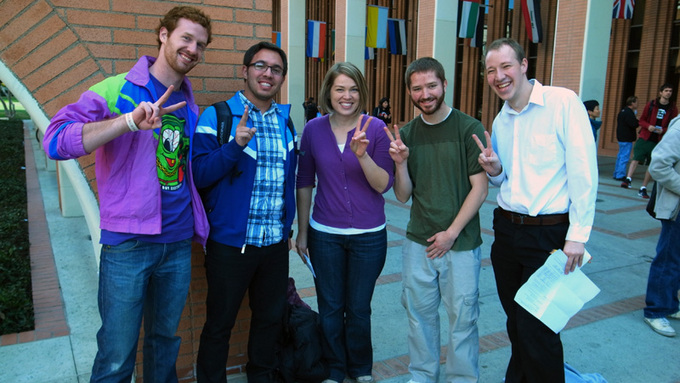
The test-takers from Utah (It looks like they are copying the peace sign that is so popular in Japanese photographs.)
My next group of interviewees was a trio from the San Fernando Valley: Susan, Jared and Mathew. I spoke to them after the test was over. Susan told me that she had just spent two weeks traveling in Japan in September 2011, visiting Okinawa, Fukuoka, and Tokyo. She was impressed by Japanese food, and by how safe it was for a woman to travel alone around the country. She added that she is a big fan of the Japanese game show Nep League, which she said is broadcast every week on the local television station. Susan did have one complaint, though: the subtitles that you often see on Japanese variety shows disappear too quickly. She also wanted to know the purpose of those subtitles, but I wasn't able to explain that very well.
Jared told me that when he was growing up his father would often tell him stories about the Zatoichi movies, which he had gone to see with Jared's grandfather in Little Tokyo in downtown LA. Perhaps influenced by those stories, Jared was later drawn to Nintendo games and Japanese manga that tended to have ordinary kids as the main characters rather than superheroes like Superman or Batman in American comics. In college, he didn't think twice about choosing Japanese for his foreign language requirement. Since graduating from college, Jared has been spending his spare time at a manga translation group, translating his favorite manga into English. He said he tries to express the manga in natural sounding English without losing the flavor of the original. Jared's dream is to get into the JET programme and live in Japan someday.
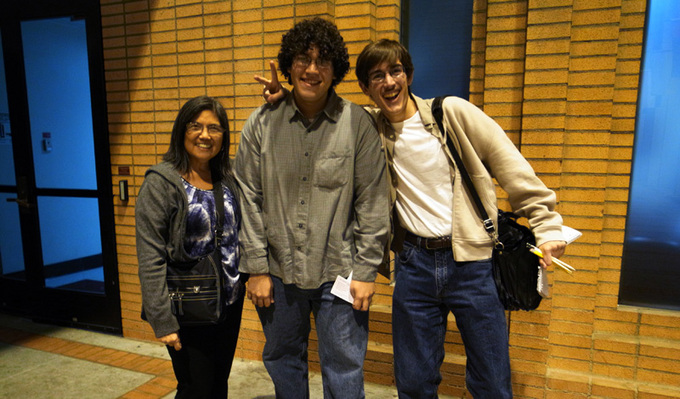
The trio from San Fernando Valley (from left: Susan, Mathew, and Jared)
Looking back, 2011 was a tumultuous year in Japan. For some, the great Tohoku earthquake, tsunami, and subsequent nuclear plant accident in Fukushima literally turned the world upside down. In spite of everything, though, we still have Japanese language learners whose eyes sparkle at the thought of coming to Japan. It made me genuinely happy to meet them in person. It is my wish to see the JLPT continue to be a bridge connecting Japan with its fans in faraway places.
Back Issues
- 2025.9.30 The 51st Japan Found…
- 2025.9.30 The Japan Foundation…
- 2025.9.30 Bringing the World C…
- 2025.9.30 The 51st (2024) Japa…
- 2025.9.30 Japan Foundation Pri…
- 2024.5.24 The 50th Japan Found…
- 2024.3. 4 Movie Theaters aroun…
- 2023.4.10 The 49th Japan Found…
- 2023.3.28 JF's Initiatives for…
- 2023.1.27 Living Together with…

